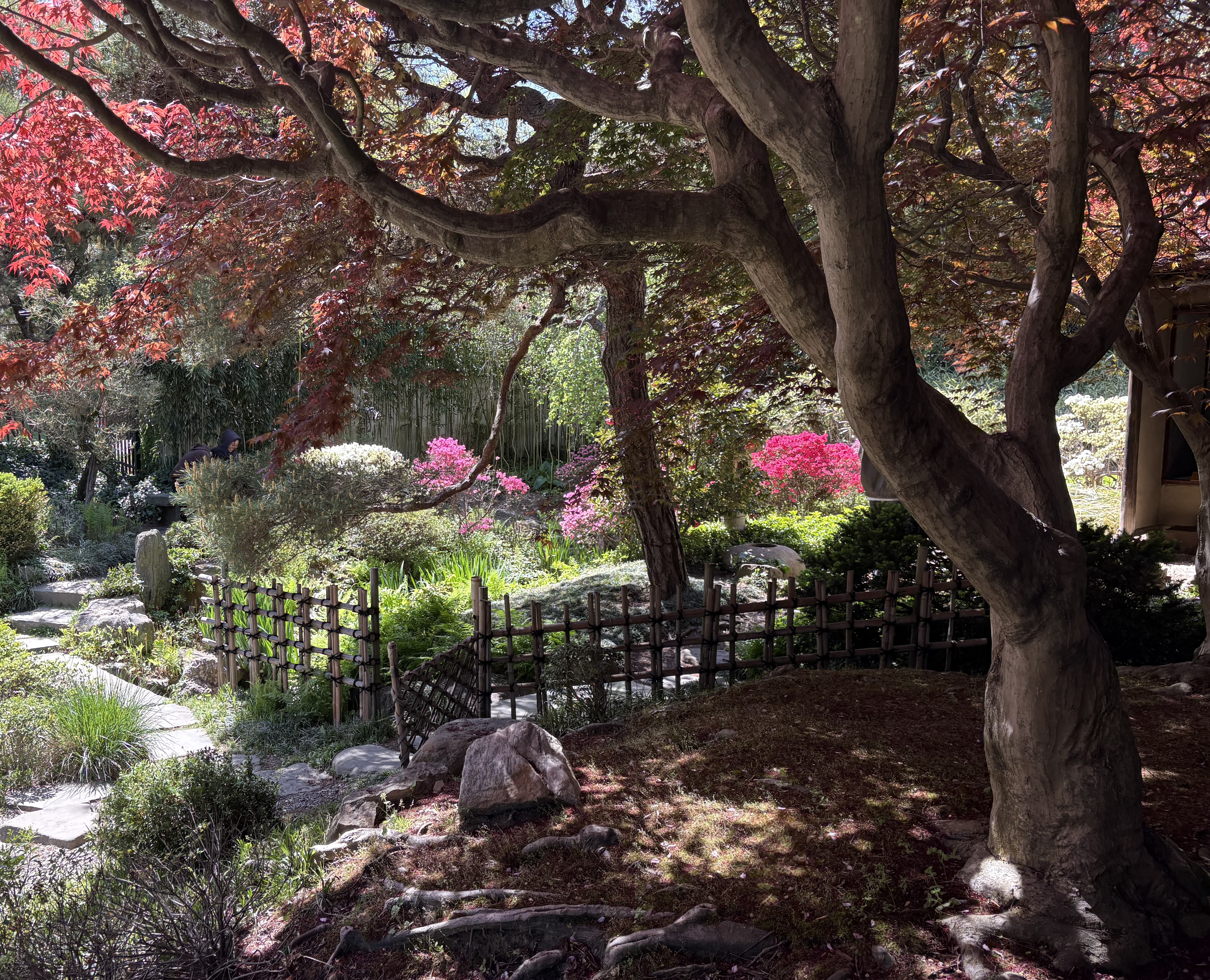
A Visit to Shofuso House |
Shofuso Garden Design & LayoutThe HenFeathers team visited the garden and home, Shofuso House, Fairmount Park, Philadelphia, PA, a masterful example of the Momoyama style, characteristic of early 17th-century Japanese gardens. Landscape architect Tansai Sano, renowned for his work at Kyoto's Ryoan-ji Temple, designed the original layout.
The garden features:
These elements are thoughtfully arranged to create a sense of natural beauty and tranquility, inviting visitors to engage in quiet contemplation and reflection. An example of this is the newly restored Pebble Beach, which can be seen along the central pond, restored in 2021 based on original 1957 drawings, enhances the garden's authenticity and aesthetic appeal. This restoration reflects ongoing efforts to preserve and honor the garden's historical design while maintaining its cultural significance. The "Borrowed Scenery" Integration with the Architecture is shown in the relationship between the house and garden at Shofuso, which is integral to its design.
Shofuso House Architecture:The architecture is designed to frame and enhance views of the natural surroundings. The house's shoin-style design, featuring tatami-matted rooms and sliding doors, allows for seamless transitions between indoor and outdoor spaces. This design philosophy emphasizes the Japanese concept of "borrowed scenery," where the natural landscape becomes an extension of the living space.
Cultural SignificanceThe garden's design elements are symbolic of Japanese culture and compliment the house's traditional Japanese architecture. Its thoughtfully designed garden, harmonious integration with the house, and cultural significance make it a unique and valuable destination for those seeking to experience the elegance and tranquility of Japanese landscape architecture.
Shofuso House HistoryShofuso Japanese House and Garden, is a serene blend of Japanese architectural elegance and natural beauty. Designed by architect Junzo Yoshimura in 1953, the house was constructed using traditional Japanese techniques and materials it was originally displayed at the Museum of Modern art in New York City. It was later relocated to Philadelphia in 1958, where it was integrated into a meticulously designed garden that reflects the principles of Japanese landscape aesthetics. |




 Shofuso House (Side View).
Shofuso House (Side View). Pebble Beach.
Pebble Beach. Entrance Walkway & Boulder.
Entrance Walkway & Boulder. Outdoor Entryway Steps & Doors.
Outdoor Entryway Steps & Doors. Perimeter Wall with Terracotta Shingles.
Perimeter Wall with Terracotta Shingles. Perimeter Wall with Bamboo.
Perimeter Wall with Bamboo. Outdoor Walkway (Engawa).
Outdoor Walkway (Engawa). Tea Room (Tea Kettle).
Tea Room (Tea Kettle). Waterfall with Boulders Across the Pond.
Waterfall with Boulders Across the Pond. Pond Side Pagoda Sculpture.
Pond Side Pagoda Sculpture. Pebble Beach.
Pebble Beach. Island Bridge in Main Pond from Pebble Beach.
Island Bridge in Main Pond from Pebble Beach. Island Bridge (Close Up).
Island Bridge (Close Up). Koi Fish in Main Pond.
Koi Fish in Main Pond. Bamboo Framed Sculpture
Bamboo Framed Sculpture Ikebana & Hallway.
Ikebana & Hallway. Waterfall Mural Room.
Waterfall Mural Room. Music Room.
Music Room. Side Engawa at Main House Looking Into Waterfall Mural Room.
Side Engawa at Main House Looking Into Waterfall Mural Room. Hidden Pagoda Sculpture.
Hidden Pagoda Sculpture. Stepping Stones Amongst the Pines.
Stepping Stones Amongst the Pines. Stone Path, Fork in the Road.
Stone Path, Fork in the Road. Stepping Stone Bridge with Creek.
Stepping Stone Bridge with Creek. Stepping Stone Bridge (Close Up).
Stepping Stone Bridge (Close Up). Back Pathway with Cherry Blossom Trees.
Back Pathway with Cherry Blossom Trees. Engawa in Courtyard with Creek.
Engawa in Courtyard with Creek. Courtyard with Creek Running through It.
Courtyard with Creek Running through It. Courtyard Creek from .
Courtyard Creek from . Courtyard Path.
Courtyard Path. Sliding Doors Framing Ikebana.
Sliding Doors Framing Ikebana. Sliding Doors Framing Ikebana.
Sliding Doors Framing Ikebana. Pagoda Sculpture Looking Back Towards House.
Pagoda Sculpture Looking Back Towards House. Pagoda Sculpture Overlooking Pond.
Pagoda Sculpture Overlooking Pond. Pagoda Sculpture with Flowers.
Pagoda Sculpture with Flowers.









